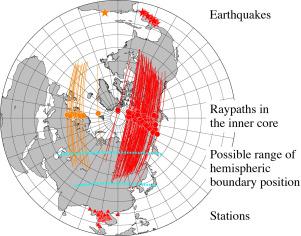Physics of the Earth and Planetary Interiors ( IF 2.3 ) Pub Date : 2020-12-26 , DOI: 10.1016/j.pepi.2020.106636 Toshiki Ohtaki , Satoru Tanaka , Satoshi Kaneshima , Weerachai Siripunvaraporn , Songkhun Boonchaisuk , Sutthipong Noisagool , Kenji Kawai , Taewoon Kim , Yuki Suzuki , Yasushi Ishihara , Koji Miyakawa , Nozomu Takeuchi

|
The Earth's upper inner core has a quasi-hemispherical velocity structure. One of the two quasi-hemispheres has a high-velocity region centered beneath Southeast Asia and is referred to as “East”. The remaining low-velocity region is referred to as “West”. The boundary positions between the quasi-hemispheres are rather scattered but well estimated at low- and mid-latitudes, whereas discrepancies between seismological hemisphere models increase at high latitudes. However, the boundary position at high latitudes is important when considering the origin of the quasi hemisphericity. Recent deployment of a temporary broadband seismic array in Thailand (Thai Seismic Array; TSAR) provides a means to analyze the inner core structure in the north polar region because rays from Central American earthquakes to the network are transmitted through the inner core and have their turning points approximately 150–400 km beneath the north polar region of the inner core boundary. We measured the differential traveltimes of earthquake waveforms between a seismic phase transmitted through the inner core (PKIKP, DF) and a phase that turns in the lower outer core (PKPbc, BC). The observed differential times are approximately 0.2–0.3 s smaller than theoretical estimates predicted by the Preliminary Reference Earth Model (PREM) over the observed distance range and 0.3–0.5 s smaller than those of AK135 at larger distances, which suggests lower velocities in the analyzed region of the upper inner core. Our analyses show that models with velocities ~0.03 km/s lower than those of PREM in the upper 300 km of the inner core, with a velocity about midway between PREM and AK135 in the F layer, sufficiently fit the observed differential times. This low-velocity feature in the upper inner core is characteristic of the “West”. The observations are also largely explained by the model obtained for the structure beneath the northeast Pacific in mid-latitudes classified as “West”. Our previous study also shows that the south polar region of the upper inner core has “West” characteristics. Our results thus suggest that the north and south polar regions of the upper inner core have a “West” structure and that the Earth's upper inner core has an eyeball-shaped high-velocity anomaly called the “East”. The shape of the hemispheric boundary is possibly an ellipse shortened in the north-south direction rather than a circle.
中文翻译:

北极地区上内核的地震速度结构
地球的上部内核具有准半球速度结构。两个准半球之一具有一个以东南亚为中心的高速区域,被称为“东部”。其余的低速区域称为“西部”。准半球之间的边界位置相当分散,但是在低纬度和中纬度地区得到了很好的估计,而在高纬度地区,地震半球模型之间的差异却越来越大。但是,在考虑准半球形的起源时,高纬度的边界位置很重要。最近在泰国部署了一个临时宽带地震阵列(泰国地震阵列;TSAR)提供了一种分析北极地区内部核心结构的方法,因为从中美洲地震到网络的射线是通过内部核心传输的,并且其转折点位于内部核心北极区域下方约150-400 km边界。我们测量了通过内芯传输的地震相位(PKIKP,DF)和在下外芯旋转的相位(PKPbc,BC)之间的地震波形的差分传播时间。在观察到的距离范围内,观测到的微分时间比初步参考地球模型(PREM)预测的理论估计值短约0.2-0.3 s,在更大距离下,其观测值比AK135的理论值小0.3-0.5 s,这表明分析中的速度较低上内核的区域。我们的分析表明,模型的速度比内芯上部300 km的PREM的速度低约0.03 km / s,且速度在F层的PREM和AK135之间大约为中间速度,足以拟合观察到的差分时间。上部内芯的这种低速特征是“西部”的特征。在中纬度被归类为“西部”的东北太平洋下面的构造所获得的模型也很大程度上解释了这些观测结果。我们之前的研究还表明,上部内核的南极地区具有“西部”特征。因此,我们的结果表明,上部内核的南北极区域具有“西”结构,地球的上部内核具有眼球状的高速异常,称为“东部”。


























 京公网安备 11010802027423号
京公网安备 11010802027423号